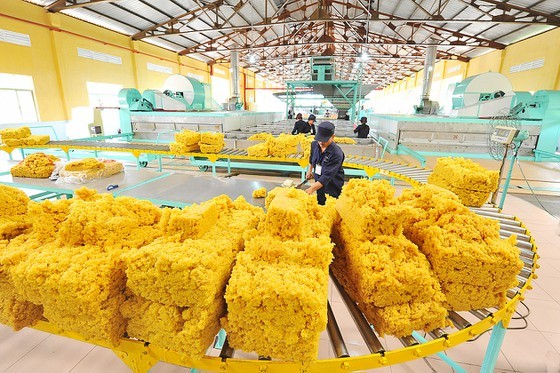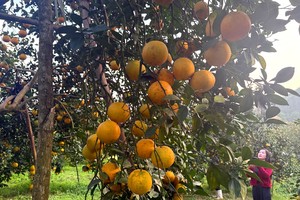 Workers of a rubber processing company
Workers of a rubber processing company
In the first nine months of 2021, rubber export reached 1.3 million tons, earning more than US$2.1 billion, up 17 percent in volume and 52 percent in value compared to 2020.
Currently, China is Vietnam’s main export market, accounting for about 70 percent of Vietnam's total rubber exports. However, the country is changing its policy, adding more technical barriers. Furthermore, although the amount of rubber in small farms accounts for more than 50 percent of the output, the quality is not stable.
In these days, workers in the rubber farm of Phu Rieng Rubber Company in the Southern Province of Binh Phuoc under the Vietnam Rubber Industry Group (VRG), have been busy with harvesting latex. Elsewhere in the province, owners of rubber smallholdings are also seeking workers from other localities to harvest rubber latex.
Unlike many years ago, the price of rubber this year remained at more than VND40 million (US$1,767) per ton; sometimes, it reached VND 45 million - VND46 million per ton. In comparison to the period from 2012 to 2020 when the price of dry rubber latex was only VND30 million a ton, rubber prices hiked over VND10 million this year.
According to the Vietnam Rubber Association, the export growth of rubber stayed high in recent years thanks to high demand in China which has bought about 70 percent of Vietnam's total rubber output. In addition, Vietnam is also the 11th largest supplier of rubber to the US with 30,000 tons, up more than 90 percent over the same period.
Thanks to better investment in rubber care techniques compared to other countries, in recent years, rubber trees have not had leaf fungal diseases any longer; therefore, the productivity of Vietnamese rubber is high. Meanwhile, about 0.6 million hectares of mature rubber in Indonesia, Thailand, Malaysia, Sri Lanka, India, China were destroyed. In addition, unseasonal rains also disrupted latex harvesting in Thailand, Malaysia and India. It is forecasted that from 2021 to 2024, the world will see new rubber price because the supply of rubber is decreasing, so Vietnam's rubber exports can continue to benefit in price.
One reason for the increase in price of Vietnamese rubber is because Vietnam improves its rubber quality much.
Many rubber companies and owners of rubber smallholdings have been applying science and technology for cultivation and production. For example, VRG set up two hi-tech agricultural zones and 13 high-tech agricultural projects on an area of 4,370 ha. The company anticipated the revenue will reach about VND48,000 billion and the profit will be over VND10,000 billion by 2025.
Meanwhile, Dong Phu Rubber Company poured money into the upgrade of three latex processing factories using advanced technology. The total design capacity of the factories reaches 9,000 tons of block latex, around 6,000 tons of latex, and 3,000 tons of RSS sheet latex. Following suit, Phu Rieng Rubber Company also applied science and technology continuously to maintain the productivity of over two tons per ha.
Currently, rubber products of 260,000 rubber smallholdings are playing an important role in export because they account for 51 percent of the total rubber area of the country and nearly 62 percent of the total amount of latex in the country.
However, experts in the field said that with more than 80 percent of smallholders with rubber plantation area of 0.8-1.5ha have not applied techniques and not complied with regulations towards sustainable development. Therefore, the rubber latex quality of these smallholdings is unstable.
This has made the selling price of Vietnam's rubber often lower than that of other countries. In addition, many smallholder farmers lack information about many stages in the supply chain, or quality standards for input rubber latex, which can create risks for the Vietnamese rubber industry when join the export market in the future.
According to the Vietnam Rubber Research Institute, the State and some organizations have supported the development of smallholder rubber. However, the scale of these activities is often small, not enough to bring practical benefits to the majority of smallholders.
In a recent workshop, Vice President and General Secretary of the Vietnam Rubber Association Vo Hoang An, suggested that smallholders should join together setting up a cooperative which will link up with large companies for a sustainable production model.
Furthermore, specialized management agencies need to develop a set of national quality standards as a legal basis as well as encourage rubber businesses to build linkage models between smallholders and businesses, create source of raw materials not only to ensure stable quality but also to meet the criteria of sustainability according to future market requirements.
























